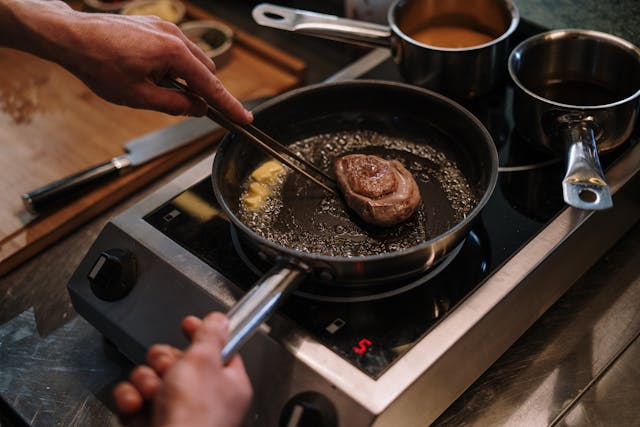
Why don’t things stick to Teflon? Things don’t stick to Teflon because the bonds between the atoms in Teflon are so strong that nothing else can stick to them. Teflon is actually a plastic, not a metal. Its chemical name is polytetrafluoroethylene (PTFE). Teflon is a brand name, which is why it is always written with a capital T.
Teflon was one of the many things that were discovered by accident when people were trying to make something else. Dr. Roy J. Plunkett, an American chemist, was working for a company called E. I. du Pont de Nemours and Company. The company still exists, but it is just called DuPont. It is the world’s largest chemical company. Dr. Plunkett was trying to make a new refrigerant, and he noticed that the gas he was using had run out before the bottle was empty. He sawed the bottom off the bottle and found a white, waxy, and very slippery substance all over the inside of the bottle. It was only used on frying pans in 1954 when Colette Gregoire persuaded her husband, an engineer, to try and make one. He did, and now no kitchen would be complete without a Teflon frying pan. However, because of all of its useful properties, kitchenware is only a small percentage of the uses that Teflon has. Let’s start by looking at frying pans.
If you use a regular pan, it is nonstick to begin with, but the more you use it and the more you wash it, the more food will stick to it. This is because the surface of the pan becomes very rough, and it is very easy for molecules of the food you are cooking to get into the cracks and stick there. The layer underneath the nonstick layer is always metal, and food molecules have no problem connecting to the molecules in the metal. That doesn’t happen with Teflon.
Teflon is made of carbon and fluorine atoms, and the bond between these atoms is incredibly strong. We have looked at the bond in water molecules before and learned how strong it is. This is because the oxygen atom is bigger than the two hydrogen atoms, and this makes a molecule with a positive end and a negative end. That makes it very easy for the water molecules to stick to each other and means you need a lot of energy to break them apart. Teflon has the same thing, but on a significantly greater scale. The bond between carbon and fluorine is one of the strongest single bonds in all of chemistry. This bond is so strong because fluorine is an incredibly negative molecule. And I don’t mean it is always looking on the dark side. Because it is so negative, it attracts the molecules from the carbon atoms and holds onto them for dear life. This makes the bond very strong. Then, when the molecules start to stick together in polymers, it makes the bonds even stronger. The advantage of this is that it is impossible for other atoms to interrupt this bond and stick to the fluorine and the carbon. Anything you put on the pan, even water, will just slide off.
An often asked question is how do you stick nonstick Teflon to a regular frying pan to give it the coating? Why doesn’t it just fall off? There are two ways. The first way is to scratch the surface of the regular frying pan as much as possible and then pour a little bit of Teflon on it. The liquid Teflon goes into the scratches in the metal and sets. When you pour the Teflon layer on top, the Teflon in the cracks gets stuck and holds on, almost like a rock climber’s gear in a cliff face. Then the outer Teflon layer sticks to the lower Teflon layer. The second way is to coat the underside of the Teflon layer with a chemical that can pull off the fluorine atoms from just that surface, making it sticky.
Because the bonds in the molecules are so strong, Teflon has very low friction as well. Molecules just slide past without catching on it. Teflon is often used in gears and machine parts due to its low friction. However, the greatest use of Teflon is in wiring insulation. This is because it has very good insulation properties. It is also very resistant to heat and doesn’t react chemically to many things. It is a very bad conductor of electricity, so the electricity running through the wires will stay in the wires. And this is what I learned today.
Sources
https://www.teflon.com/en/news-events/history
https://www.scientificamerican.com/article/if-nothing-sticks-to-tefl
https://www.explainthatstuff.com/nonstickpans.html
https://en.wikipedia.org/wiki/Polytetrafluoroethylene
https://en.wikipedia.org/wiki/Roy_J._Plunkett
https://www.waste360.com/pfas-pfoas/the-science-of-pfas-finding-strength-in-the-single-bond
https://en.wikipedia.org/wiki/Carbon%E2%80%93fluorine_bond
Photo by cottonbro studio: https://www.pexels.com/photo/person-cooking-on-black-frying-pan-4253299/
